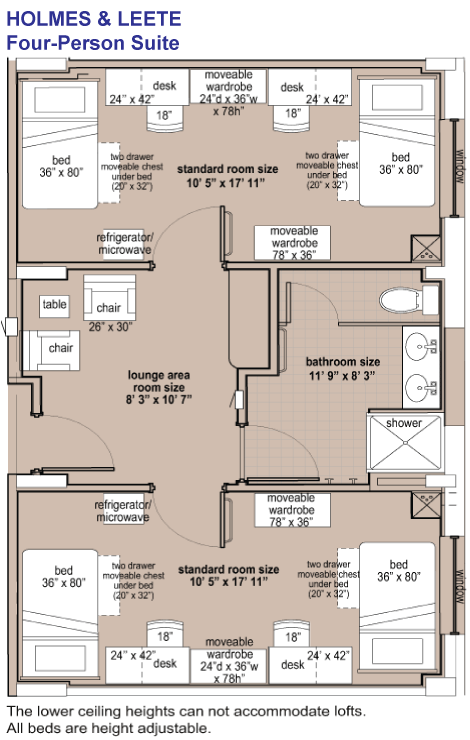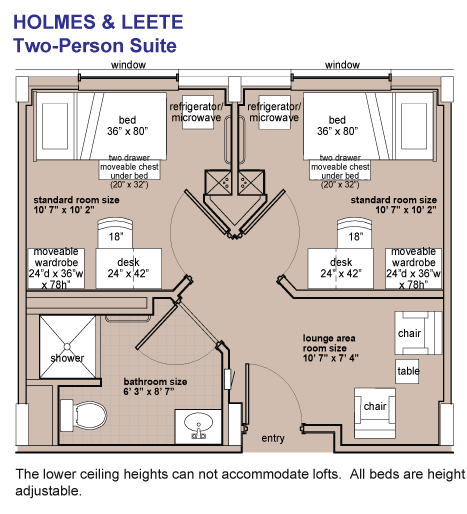Index
Past Reunions
- The 2021 Reunion
- The 2019 Reunion
- The 2016 Reunion
- Leete
2011:
On Our Way to the 60’s - Reunion 2006
- 2001: A Leete Odyssey
- The1996 Reunion

Promote Your Page Too
ICS Past

Steve Van Zandt
Leete Hall Trivia
How much do your remember about your Leete Hall days? Here's some trivia questions to get started. Please send in your own questions (and the answers) so we can expand the quiz. And don't forget to checkout our own ICS Trivia quiz on Alexa- One year, there was a tie for Emperor of the North. The winner was awarded the title of emperor after eating something on stage. What did he eat?
- There were two major annual outdoor music concerts at Penn State every year. What was each called?
- What Leete Hall resident was bitten by a bear while at Penn State?
- What do the initials "BYT" stand for?
- Name the dorms and dining hall in North Halls.
- What course, featuring TV shows, did Ellis Grove teach?
- What was the name of the North Halls snack bar, and the lady who ran it?
- What local bar band was famous for the song with the lyrics, "waitress, o' waitress..."?
- What fraternity was famous for their painted pledges running amuck in "island wear"?
- What were the other interest houses in North Halls, and what dorms and floors were they in? (partial credit will be given!)
- What was the term used for rigging a locked dorm door, so that it couldn't be opened from the inside?
- Why is the Jeopardy home page included in Links of Interest on this page?
- What was the nickname for the introductory geology course taken by many to fulfill a science requirement?
- What was the price of a pool game in the Lounge?
- How many urinals were in the girls bathroom?
- What is a shrimpo?
- How did they get the rainbow on the roast beef in the dining hall? (We haven't seen one since we left)
- What was the name of the dance performed in the hallway? (Extra credit if you can name the song and artist)
- What year was ICS founded?
- What was the last year for the ICS Interest House?
Stumped? Click for the answers.
What's
Changed, What's the Same

- While grilled stickies are still available in stores, the diner is being torn down, as of June 2019. Most recently called "The Diner," it's been the College Diner, the New College Diner, and Ye Olde College Diner.
- Munchies went down hill in the late 70's and soon thereafter disappeared
- The Creamery still sells some of the best ice cream anywhere. There's now a new creamery where the actual production takes place, the Berkey Creamery.
- The Train Station closed its doors, and no longer exists
- Basketball and gymnastics have moved from Rec Hall to the new Bryce Jordan Center
- Sadly, Playland closed down in December '03, after over 30 years of operation (including visits from Leete alumni during the 1996 and 2001 reunions). It opened in 1968, and had been open seven days a week until 4 AM since 1969.
- You can still visit deer at the Penn State deer pens out by the bypass
- Telephones first moved into the rooms, not in the hall, shared by 3 other rooms, and I believe have since disappeared altogether.
- Last I knew, there were LAN drops for 2 computers, and a cable TV hook-up. But that was before Wi-Fi. I don't know what the rooms have now.
- Interest Halls still exist at Penn State.
- You don't have to bring your own microwave: a combination refrigerator/freezer/microwave is in every room.
-
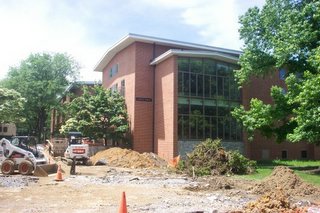 As
recently as the '96 reunion, Leete still had that strange, red carpet material
on the hallway ceilings, however Leete has been gutted and re-done as 2 and 4
person suites with their own bathrooms. Can you believe it!? Checkout
Room Layout, below, for the floor plans we all new and
loved, and the new suite floor plans.
As
recently as the '96 reunion, Leete still had that strange, red carpet material
on the hallway ceilings, however Leete has been gutted and re-done as 2 and 4
person suites with their own bathrooms. Can you believe it!? Checkout
Room Layout, below, for the floor plans we all new and
loved, and the new suite floor plans. - Sera-Tech (sp?) is now Biolife, but they will still buy your plasma.
- The Skeller closed, having opened 3 days after prohibition ended. However Doggie's Rathskeller and Garden has replaced it, keeping the Skeller's tables.
Baby Boomer Quiz Sample
Copyright by Baby Boomer HeadQuarters - WWW.BBHQ.COM - the site on the Internet for those with the boomer spirit. Reprinted with permission. All other use prohibited.- What helps build strong bodies 12 ways?
- Long before he was Muhammad Ali, before he was The Greatest, we knew him as ______________.
- Although Mario Savio said it first, we remember that Bob Dylan advised us never to trust anyone ____________..
- From the early days of our music, real rock 'n roll, finish this line: "I wonder, wonder, wonder wonder who; ."
- And confirming that the 70's were really nuts, early and late boomers alike remember the gift for the person who had everything... and needed nothing. It came in a small, cube-shaped box, with holes in the top and sides for fresh air, and included feed and caring instructions for a ________.
- Meanwhile, back home in Metropolis, Superman, disguised as a mild-mannered reporter for a great metropolitan newspaper, fights a never-ending battle for "truth, justice, and _____________________." (3 words)
- "I'm Popeye the sailor man; I'm Popeye the sailor man. I'm strong to the finish, _________________. I'm Popeye the sailor man."
- In the movie, The Graduate, young Benjamin Braddock, played by Dustin Hoffman, was counseled about his future, and told to consider one thing: ___________
- In another movie from the late sixties, Paul Newman played Luke, a ne'er do well who was sent to a prison camp for cutting off the heads of parking meters with a pipe cutter. When he was captured after escaping from the camp, the camp commander (played by Strother Martin) used this experience as a lesson for the other prisoners, and explained, "What... we've got... here... is ________________."
- In 1962, a dejected politician chastised the press after losing a race for governor while announcing his retirement from politics. "Just think what you're gonna' be missing; you don't have __________________________ to kick around any more."
ICS Scrapbook
Just Another Brick in the
Wall Path

The Penn State Alumni Society has a program for buying bricks in the Alumni Walk, located between the University House and the main building of the Hintz Family Alumni Center. Our interest house is immortalized by four bricks funded through a number of ICS alums:




If you are visiting Penn State and want to find the bricks, go to the PSU Alumni Society's Brick Finder and search under the name "Fortier".
Photos from the 70's
Checkout some thumbnail photos. Some of the full-sized versions are on-line, and I hope to have the rest up soon, now that I have more memory available. Also, if you have any old photos, please send me an electronic copy or loan a print to me, and I'll digitize them for use here and return them. Kathy
Garland, Randy (Santa) Hoffman, and Sandy Boyd
Kathy
Garland, Randy (Santa) Hoffman, and Sandy Boyd
 Doug
Lalama, Jim Haggerty, and Dona Gasper
Doug
Lalama, Jim Haggerty, and Dona Gasper
![]() Tim
Butler and Julie Klippa
Tim
Butler and Julie Klippa
 Trick
or Treat! Jeannette Roolf, Ed Mohoric, Phil Rettabek, Kathy Nuss, Ginny Kent,
Rob Quivey, Joan Walters, Donna Fane, Donna Gasper, Paula Matusky and Sue
Piskai. (Thanks to Kathy Nuss Coyle for providing the missing names!)
Trick
or Treat! Jeannette Roolf, Ed Mohoric, Phil Rettabek, Kathy Nuss, Ginny Kent,
Rob Quivey, Joan Walters, Donna Fane, Donna Gasper, Paula Matusky and Sue
Piskai. (Thanks to Kathy Nuss Coyle for providing the missing names!)
 Trick
or Treat Redux! Chris Rackham, Donna Gasper, Bill Kardash, and Doug Lalama
Trick
or Treat Redux! Chris Rackham, Donna Gasper, Bill Kardash, and Doug Lalama
 And
one final Trick or Treat photo (or did these folks always dress this way?) Dan
Fortier, Chris Rackham, Eric Geisy, Suzanne Dulan, Bruce Krebble, and Joe
DiMarco.
And
one final Trick or Treat photo (or did these folks always dress this way?) Dan
Fortier, Chris Rackham, Eric Geisy, Suzanne Dulan, Bruce Krebble, and Joe
DiMarco.
 I
think this picture came from around Christmas 1978. Thanks to Kent Erdman, we
now have at least first names for everyone. From left to right: Karl Meckert,
Donette Miketa Dewar, Kent Erdman, Ginger Hart, Lynn Nowacki, and Jim ?
(Thanks to Ro Katrack for providing the missing names).
I
think this picture came from around Christmas 1978. Thanks to Kent Erdman, we
now have at least first names for everyone. From left to right: Karl Meckert,
Donette Miketa Dewar, Kent Erdman, Ginger Hart, Lynn Nowacki, and Jim ?
(Thanks to Ro Katrack for providing the missing names).
 Randy
Hoffman, Sandy Boyd, Eric Yoder, Mary Ellen Nepps (not from PSU), Gena Cadieux,
Mike McGurrin, Tom Chismar, and Allisson Glenn, 2nd Annual Big Chill Party
(1985)
Randy
Hoffman, Sandy Boyd, Eric Yoder, Mary Ellen Nepps (not from PSU), Gena Cadieux,
Mike McGurrin, Tom Chismar, and Allisson Glenn, 2nd Annual Big Chill Party
(1985)
 Who's
the mystery man in drag? Rumor has it he did time as the ICS Resident Assistant.
Who's
the mystery man in drag? Rumor has it he did time as the ICS Resident Assistant.
 North Halls t-shirt, 1977.
North Halls t-shirt, 1977.
 ICS t-shirt, 1977.
ICS t-shirt, 1977.
ICS Newsletters
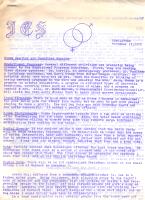 Bring back any
memories? When was the last time you saw a mimeograph?? We have 2
newsletters:
Bring back any
memories? When was the last time you saw a mimeograph?? We have 2
newsletters:
- The October 1972 Newsletter as a pdf (some is illegible)
- The November 1972 newsletter,
both as pdf (some is illegible) and as mages::
page 11|| page 22||
pagee 3
Articles on ICSArticles on ICS
- 1971 Courier-Express article from Dubois, Pennsylvania
- 1971 Daily Collegian article, quoting Ann Stephenson
- 1972? Daily Collegianarticle, quoting Christal Mokenhaupt
- 1973? Daily CollegianArticle, quoting Jeff Wall
Leete Hall
2007 marked the 50th anniversary of Leete Hall. Construction began in 1957. It was rebuilt in 2005, as described below. It was named after John H. Leete. In addition to teaching mathematics, Leete was a leader of the faculty literary club and, along with Lewis Pattee, co-founded the Penn State Thespians. He taught at Penn State from 1895-1906, when he left to be the first dean of engineering at the Carnegie Institute of Technology (now Carnegie Mellon). ICS was one of the first interest houses, founded in 1971. It ran through around 1982 or 1983, when it was either replaced or renamed the "Social and Self Awareness" interest house.
Original Floor Plan
Here's the original 1st floor plan from the Penn State archives:

Room Layout
Think you don't have enough room for everything? Just think back on when you and your roommate both had to fit everything here:
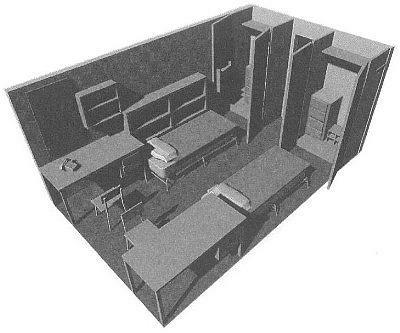
Nowadays, the Leete room options are:
Gentle Thursday
I received an email awhile back from someone who helped organize Gentle Thursday's in the late 60's at the University of Oklahoma, and he said they had gotten the idea from folks at the University of Texas. There's also information on the net about other Gentle Thursdays (often weekly concert events, rather than Penn State's one per spring). Apparently many campuses had such events.
Penn State Press Release on ICS
12/14/79
Although they come from diverse backgrounds, a common interest in people brings them together.
They are the students in the Individual in a Complex Society (ies) Interest House at The Pennsylvania State University.
This interest house is one of several at Penn State, established on the basis that "an academic and intellectual life is enhanced not only through the classroom experience, but through activities outside the classroom, particularly in a residence setting."
"I have really enjoyed the uniqueness of the interest house setting," says Maria Gressang of Springfield, a senior general arts and science major and resident assistant in the ICS interest house. "The atmosphere is very relaxed, congenial and healthy for study."
A cross between a departmental or specialty club and a fraternity or sorority, the interest house also enhances student life through programs emphasizing faculty-student relationships.
Started in 1971, there are now 10 interest houses on the campus, providing students with similar academic fields a social and study-conducive atmosphere.
Each interest house has a faculty adviser and an advisory committee comprised of students who plan and coordinate the social and academic events of their particular house.
Recently, students from the ICS house took a field trip to nearby Bellville to meet and talk with members of the Amish community there.
"What we wanted to do," says Ms. Gressang, "was observe the Amish community and see how they have changed as society has changed. We were able to find out some very important things from them--such as buggy styles and clothing styles."
Dr. Lance Shotland, associate professor of psychology and faculty adviser to the ICS interest house, says the trip to Bellville was very beneficial.
"The students were able to learn many things they would not in classroom. By talking to the people, they got a first-hand history of the Amish and how they are learning to cope with a rapidly changing society.
The house plans a similar trip to New York City where members hope to meet with members of the Hasidic Jewish community.
Although the close proximity of other students with the same interests provides a conducive atmosphere for study, the interest house is also useful for other purposes, says Janet Begin, director of the interest house program. Besides field trips, the houses sponsor movies, discussions and visits with faculty families.
Contact among students with similar interests is an important aspect of the interest house program. Of equal importance is the contact among younger and older students. The interest house also helps to personalize a large university campus.
Other Penn State interest houses are: Arts and Architecture, International Languages, Business, International Cultures, Renaissance, Life Sciences, Multiple Role Development, Intercollegiate Academic, Earth and Mineral Sciences.
 Caving
Caving
An activity that many of us took part in was the occassional caving trip, as Centre County is blessed by a number of caves. These included Sharers Cave and J4. Often we'd do this if we hadn't found anything else to do in the evening, and I'd often be asked, "You go caving at night?" I'd just wait, and it would dawn (so to speak) on the questioner that inside a cave it really didn't matter if it was day or night. J4, as shown in the pictures below, had a unique entrance involving a lenght of sewer pipe, a metal door, and a locked door within the door. And that entrance was located partway up a quarry wall! To get in, you unlocked the door within the door (keys managed by the Nittany Grotto caving club), reach your arm in, and slide back the bolt holding the larger door closed. This way, only those with a key could get in, but you couldn't be accidentally locked in. Regrettably, J4 has been closed by the current landowners for many years, and I'm not sure of the status of Sharers.
In addition to natural caves, some ICS residents were known to partake in unauthorized explorations of the steam tunnel system that runs underneath the campus.




